Against the Current: A Two-Part Interview with Karl Lemieux
(and Daïchi Saïto)
By Brett Kashmere
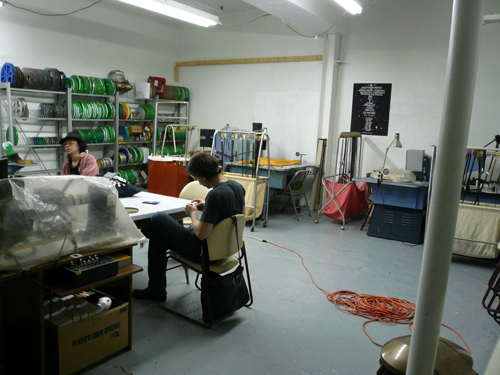
Saïto and Lemieux in the Double Negative Studio, Montreal
Photo: Brett Kashmere
PART TWO: Double Negative (with Daïchi Saïto)
In part two of the interview, Double Negative co-founder Daïchi Saïto joins us to discuss the origins, philosophy, and future direction of the Montreal-based filmmaking collective.
BK: Can you tell me about the origins of the Double Negative, where the name came from, and how you arrived at the idea of starting a collective?
DS: We started in 2004. Basically, Karl and I sat down and talked about it. The actual forming of the collective came later. At that time, we were sitting in a bar. We spent a lot of time talking about it. At some point we decided to stop talking about it; let’s do it. First we figured out who would be interested in doing this kind of thing with us, who we liked to work with, most of them coming from Concordia [University]. Then we contacted them; basically they were all interested. We explained the idea.
BK: It seems like a lot of the members all came out of one experimental filmmaking class that Richard Kerr taught.
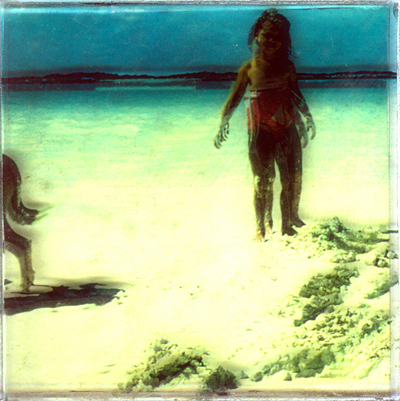

Top to bottom: Paper Nautilus (Amber Goodwyn); Untitled (Lucia Fezzuoglio)
Courtesy of Double Negative.
DS: That’s right. Karl was there, though he wasn’t an official student, Eddie [Menz], Julien [Idrac], Amber [Goodwyn], Chris [Payne]. Some other people, like Lucia [Fezzuoglio], I knew from outside of the class. I didn’t know her very well, but I knew her through working together in the Steenbeck editing rooms. I was working on my film, staying up all night, sleeping at school. The only other person that was there was Lucia, so we exchanged conversation about our work.
One thing I was thinking about at the time: these film students, once they finish film school, often get lost without access to equipment; they lose their peers. They can’t keep making films like they want to, like they were doing in school. So the collective was also a way to prevent that from happening, for myself, too.
The only option we have in Montreal, to gain access to equipment, is to join Main Film [a filmmaking cooperative]. But the core of what we do is very personal. It’s a group of artists getting together with a certain connection between them, working together. Main Film doesn’t work that way. You pay a fee, you become a member, you get access to equipment; but on a more personal, artistic level, there’s not much communication going on. It’s an organization. That’s something we wanted to avoid. To make what we’re doing, in a way, different from that model.
BK: What happens if someone wants to become a member of the collective?
DS: That’s something we have difficulty with. There’s no policy–we don’t have a policy for anything. [Laughter.]


Top to bottom: Frames from Pan of the Landscape (Christopher Becks); El jardín de senderos
que se bifurcan (The Garden of Forking Paths) (Malena Szlam) / Courtesy of Double Negative
KL: We added two new members recently: Christopher Becks and Malena [Szlam]. They’re two filmmakers making extremely interesting work, and who were interested in what we were doing; they were just natural additions. There have been people in the past who wanted to join the collective but it wasn’t obvious they were truly passionate about what they were doing. We couldn’t see how they would bring anything to the group. These additions could be endless: we could become 60 people, but it would be impossible to organize
BK: Then you end up becoming a cooperative, by default.
DS: Yeah, exactly. That’s not what we want [to be exclusionary], but we have to operate that way, by necessity. Because we have this [studio] space, everything’s here. All the equipment is here, which we share. That’s one characteristic of they way we work: sharing equipment. It’s hard to operate that way when people we don’t know very well are involved. Also, this is part of my apartment. There’s no bathroom in the studio, so everyone has to use mine. Each member has a key to the studio space; that means access to my place as well. So it has to be based on trust. I personally couldn’t deal with having 20 other people trying to use the studio: every time I’d have to be here. I have to be responsible for the equipment.
These are very practical reasons for why it’s difficult to expand. We’re not trying to create a secret sect.
KL: I feel like we’re closer to a music collective, or some kind of band, rather than a co-op.
DS: One thing we talked a lot about, in terms of inspiration, was Montreal’s underground music scene: Constellation [an independent music label], the Godspeed people, how they manage to do their work without being dependent on a big industry. We wondered why that isn’t possible in cinema, to do something in a very grassroots, very independent way? Also, we’re in Montreal, in Mile End. We’re very close [physically] to those people in music.
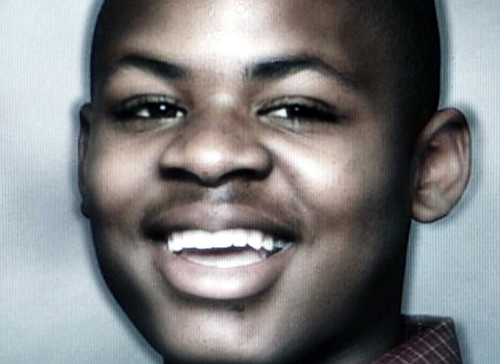
Fracas (Eduardo Menz) / Courtesy of Double Negative
BK: That’s something we touched on earlier: this sense of a community between film and music. It seems like that’s really started to develop over the last five or ten years.
KL: Like organizing the performances of Guy Sherwin at Sala Rossa [a popular music venue]. It’s natural: it brings us the same audience that supports the music scene.
BK: It’s a way of building audience.
DS: It’s opening up to people outside: like people in music, or the visual arts.
BK: Did you look towards other collectives when you were starting out, like The Collective for Living Cinema in New York? Did you research other models?
DS: I personally didn’t do that kind of research, but I would think a lot about how the American experimental film scene developed, and the things that were happening there in the 60s and 70s. That was certainly an inspiration, that ethos. It’s not about how things were organized; it’s about the spirit. Stories of Jonas Mekas sleeping under the Steenbeck because there’s no room after inviting some people over to his place, to make films. That kind of communal experience, very informal, but very serious at the same time, without being institutionalized–that was our beginning.
KL: I didn’t do any research either, on organizations. But we talked many times about what happened in New York, this explosion of people getting together and organizing things in different ways.
At Concordia, when I was studying in Richard’s class, it was obvious to me that I wasn’t there to get a diploma or a grade. I was there to sit with other filmmakers and share ideas, share ways of thinking about film. Being able to show a piece of film I made, receiving comments on it, seeing stuff from other people, getting inspired by it–it’s something we would have missed a lot after leaving school and being on our own.
BK: Do you feel that the work you put into Double Negative seeps into your own artistic practice?
DS: [Pauses.] Yeah. [Pauses.] It’s hard to point out what, but it does in many ways. For me personally, doing Double Negative is also a statement. It makes a statement, because it’s directly related to how you make your work. It makes a foundation for your own personal work and artistic commitment. I feel we are definitely making a statement by proposing this way of doing work. I think that’s a very important part of doing the collective. It’s almost an ethical question.
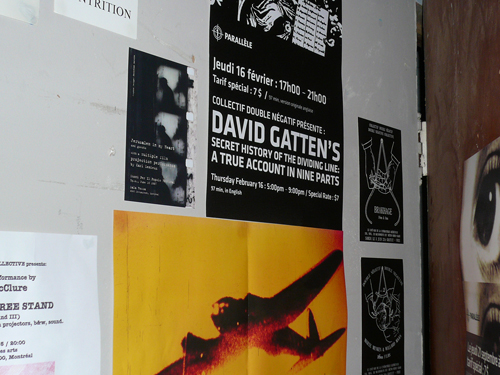
Screening posters in the Double Negative Studio
BK: You also bring in filmmakers–David Gatten, Bruce McClure, Nicky Hamlyn–which is a way of exchanging ideas with people from outside of Montreal, and also a way of exposing yourselves to work that’s going on in other places.
DS: You always have to work on your stuff, but at the same you have to keep the atmosphere, and the involvement, alive. One thing about bringing in visiting artists and organizing events and screenings, and exposing a lot of work to the public is to build up an environment for people interested in experimental cinema.
KL: By bringing filmmakers from other countries or other cities, and having this work here–we try to do it on a regular basis–it brings people together, creating a reference point for people to meet and exchange ideas.
DS: It’s kind-of a freewheeling method of organizing events, because we don’t have any budget. Everything is paid for out of our pockets. So everything is half by accident, half by luck, this artist happens to be here, and so on. That’s the only way that we could do it; so there are limitations.
BK: That just makes it all the more impressive. With the limited financial resources you still find ways of making things happen, which is more in an American tradition of organizing within the arts. In Canada, there’s more of a tendency to line up for grants and then wait around.
DS: That’s the thing: the infrastructure is already there [in Canada]. We become so dependent on that infrastructure; you cannot go outside of it.
BK: You become beholden to a mission statement, and then you’re required to only program a certain kind of work to maintain your funding. You lose the integrity of what you had at the start.
DS: That relates to the worry we have about expanding the collective. The bigger the group becomes, the more difficult it is to maintain autonomy.
KL: We can’t see ourselves as having fulltime jobs doing office work, doing all that accounting. Not that it’s never going to happen, but it would certainly be tricky to deal with.
DS: The way that we operate is not very efficient. Each member does what they can do in their capacity, covering things that others can’t. There are things that I can’t do myself, or that Karl cannot but that other members can. We compliment each other that way.
Still, it’s difficult to find a balance when there’s no structure. Who’s got more say; who’s doing more work than the others: these things can become very complicated. It has become an issue [in the past]. But we talk a lot, and we get together. It’s really based on trust; that, to me, is very important.
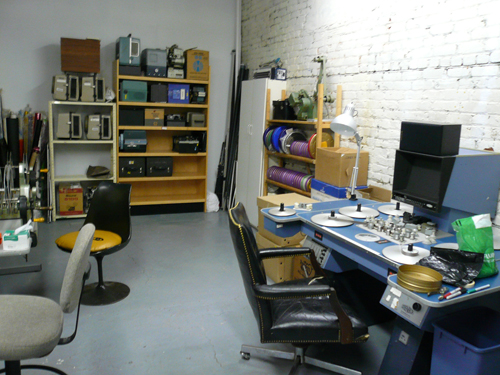
The Double Negative Studio / Photo: Brett Kashmere
For example, the studio space: not everyone uses it all of the time. But it’s at least a commitment that each member has, to keep the space. That means we each pay rent, which isn’t easy for many people. Someone might think: I’m not using this space at all, why do I have to pay rent? If people start saying that, groups like this can’t function. So that’s a basic, bottom-line agreement, and it’s been really good.
BK: How do you feel about the recognition you’ve received?
KL: The true recognition is when someone, after a screening, tells you that they’ve been totally blown away. You can feel when people are really enjoying what’s going on, and experiencing something special and unique, something they haven’t seen before. That’s the best thing we can get.
DS: I think because of the way we started and what we do, it took quite awhile to gain, if not recognition, but a certain credibility. We are not an organization funded by arts councils, dealing with this obscure corner of cinema. But by doing events and organizing screenings [on a consistent basis], I can feel that has changed.
Certainly, we did feel that it was time for something like this. It was a time when nothing was really happening; we could feel a stagnant air in the film community.
KL: Cinéma Parallèle [a non-profit organization dedicated to Canadian and Quebec independent cinema, currently housed at the Ex-Centris screening complex in Montreal] used to screen lots of these experimental films, and it some point they stopped. But now they’ve offered us the possibility of programming experimental films every season. It’s nice: we don’t have to get anything approved. We bring a program, and they show it. They have trusting us with this arrangement for almost two years now.
BK: Do you have an idea of where Double Negative is heading? Future plans?
DS: Well, we have this machine [35mm optical printer] that we have to fix. We wish that we could set up a machine for processing film: a primordial artists’ lab. In terms of models, many groups in Europe are moving in this direction, like [the artist-run film labs] L’Abomidable and L’Etna in Paris, and no.w.here in London. I think what they’re doing is really interesting. We’re not equipped like they are, though.
KL: We process our film in Daïchi’s bathtub. I mean, it’s OK for now– [Laughter.]
DS: Yeah, it’s OK for now. It’s fine. But some people come late at night, and stuff like that.

Ghosts and Gravel Roads (Michael Rollo) / Courtesy of Double Negative
BK: Where does your equipment come from?
DS: The Oxberry 35mm printer comes from New York City, from a film lab that went bankrupt. There’s a long story about this. It was supposed to be a giveaway deal, but when we got there we had to pay for it. And, the person didn’t want to give us any parts: lenses, gates, sprockets–all the most important parts. He just wanted to give us the optical bench. It was crazy. Everything was done over the phone, so there was no contract. He told me he was going to trash it the next morning, that he had already hired movers to do the job. So I had to decide on the spot. I told him not to [trash] it, that we’d be there tomorrow morning. We had to rent a truck, find a driver, and get six people down to New York City. Everything had to be done so quickly that it was kind of a gamble. But we managed to get everything–almost everything. Unless we did stuff like that, we wouldn’t have equipment like this.
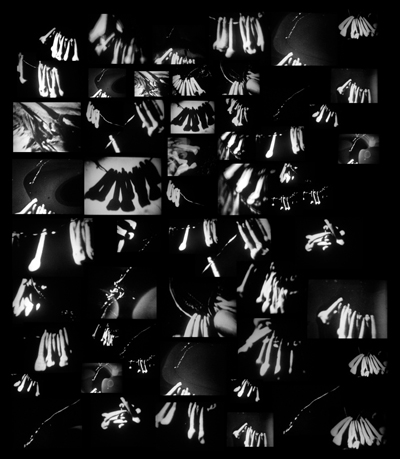
Work by Lindsay McIntyre / Courtesy of Double Negative
We have a small JK [optical printer] that belongs to Lindsay [McIntyre], another member of the collective. We have a Steenbeck and many other small pieces of equipment that belong to Karl. We have light table from Matt [Law]; Chris Payne’s projectors: a lot of sharing, and some donations. We have the photo enlarger that you gave us, and one of your projectors. John Price in Toronto gave us some stuff. Concordia [University] has been really helpful as well.
KL: Since we don’t receive support from institutions and grants, we rely on the good will of people.
DS: That’s really exciting. Also we get a lot of support from really experienced people–technicians and people like that–who think that film is dying and that their expertise is going to waste. They’re surprised that young people like us are so interested in film and trying to do something out of it. They seem to like that, and they help us. That’s very, very important in film, in experimental cinema, that passing on of knowledge. So this death of film that we talk about, it’s not really the medium that’s dying; it’s the people’s involvement and interest in the medium that’s going down. But as long as there are people who are still trying to keep that knowledge alive, and do something creative out of it, it will survive.
KL: To go back to the beginning of the collective, there’s a detail that we didn’t talk about. Daïchi was cleaning [his film] Chasmic Dance (2004) at my place; he was just finishing it. I remember he hadn’t slept for two days; he was extremely tired. It was the first time I heard him say that he didn’t want to hear about film for the next couple of hours. It was like “film film film” for such a long time. That’s when I said to him, “Well, what if we go for a beer to talk about this collective idea we had?” It was almost a joke. He looked at me and said, “Sure!” [Laughter.] That was the first time we seriously talked about it. The beauty of this is: exactly two months after this meeting on May 11th [2004], we had our first group screening, on July 10th, at the National Film Board [of Canada] Theatre [in Montreal]. To see how people responded to it, and to see how enthusiastic they were about the work–it was a beautiful positive energy that just burst out of this. Our two-month anniversary, and we were celebrating our first screening. It was packed; we had to refuse people at the door.
BK: Often the best ideas come out of sleep deprivation. [Laughter.] And the name, “Double Negative?”
DS: Oh, the name: that’s something I came up with. That’s a name that I wanted to originally use for a production company, before this collective idea. But it was perfect for the collective. Everyone else had ideas, some of them were pretty interesting, some weird ones, but we settled for Double Negative.
I think it’s a good name; it has different connotations. People can interpret it differently. What we’re doing is against the current, in a way, in the context of film becoming almost obsolete. In a way it can be seen as going backwards, into the negative. But we’re doing something positive, too. There’s also the allusion to film stock. It’s the same in French, too: “Double Négatif.” That works well in this environment.
INCITE Journal of Experimental Media
Manifest
